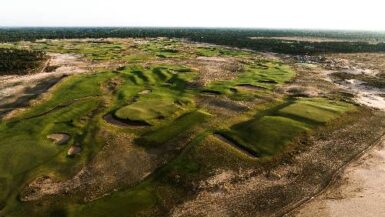MAMARONECK, NY – Set your TiVo for Fox Sports 1 this weekend, because you’ll get a rare and wonderful opportunity: Winged Foot’s East Course, in all its majesty and splendor, will finally get the close-up it so richly deserves as the USGA and the television cameras descend on the venerable club – the Yankee Stadium of golf – for the National Fourball tournament.
The West Course may host U.S. Opens and PGA Championships, but no club in the world has two courses so equally balanced in design, difficulty, and history. Unquestionably, the East course is as strong a test of golf as its more celebrated sister. Though slightly shorter than the West Course, it actually played harder than the West in score-to-par for the 2004 U.S. Amateur and frequently plays just as difficult during the Anderson Memorial, Winged Foot’s 80 year old fourball invitational event.
The East course is also prettier – prim as a cameo – traversing idyllic lakes, rugged rocky outcroppings, and the charming Mamaroneck neighborhood. If the mighty West Course is a fiery red-head, then the East Course is a sunny, smiling blonde.
“The East course just got renovated/restored by Gil Hanse, the same architect who renovated Doral for Trump and who designed the Rio Olympics course,” explained expert golf commentator Bruce Moulton. “He’s one of the two hottest commodities in golf design right now and with good reason. His work is sterling, and he finishes on time and under budget.”
Moulton is absolutely right. Everyone who has seen it counts Winged Foot East among Hanse’s absolute best restoration work, and that includes his masterstroke at Rockaway Hunting Club. The East course not only plays fast and firm, it has a pristine, pastoral feeling to it.
The East course also has a greater variety of yardages on the par-4s, which means that occasionally you may have a short iron in your hands, but you must drive the ball accurately. If you do, you may have one or two more birdie ops than on the West course.
But the East course greens also have even more undulation than the West course, (believe it or not!) If you miss the greens on the East it’s even more challenging to get up and down. Interestingly, the east course is divided into a front 10 and a back eight, adding to its unique character and charm.
Perhaps the best attribute of the East Course is the number of swing holes or “half-par” holes: holes that play a half-stroke harder or easier than the par listed on the scorecard, so scores fluctuate unpredictably. Let’s take a closer look at some of the holes that may provide the most excitement.
THE PAR-3s

Any discussion of the East Course begins with the par-3s. Each one is better than the last, and the entire collection together looks like the masterpieces of an Italian renaissance artist.
On the front, he third may be short, but the narrow green is guarded by deep bunkers and fiendish contours. Missing the green means a difficult pitch from a deep swale. The sixth climbs uphill and plays into a corner of the property where the winds swirl unpredictably.
But that’s nothing compared to the sheer terror of the 13th and 17th tee boxes, where if you miss the green you’re looking at bogey or worse for a near certainty.
“13 is my favorite hole on the golf course,” said Met Golf Association star and Winged Foot member Rob Christie, referring to the shot to the slender, pedestal green guarded by a glacier bunker set well be low the level of the green. “It’s only 145-150 yards, but if you miss that green, you’re looking at bogey or double in an instant. If you’re short, you’re in the finger bunkers, (so you’re screwed), and if you go over, you have an impossible downhill chip, (so again, you’re screwed).”
And then there’s mighty 17, a hole three-time Anderson Memorial champion Parker Smith called, “all you want and then some.”
“It’s the hardest hole out of all 36 at the club, and it does it all without a bunker,” he stated with a note of deep respect in his voice, as though he were facing the tee shot at that moment with a tournament on the line. “223 yards playing into a crosswind to a sideways green and he green has so much slope. Trying to two-putt uphill from the front is sheer murder.”
His analysis is spot on: 17 green has more twists and turns than a potato chip, but that’s what makes it so fun, interesting, and dramatic.
So there you have it – the four par-3s, in order: the center cut NY strip, the bone-in ribeye, the double porterhouse, and the chateaubriand.

THE PAR-5 12TH
The par-5s saw a lion’s share of changes during the Hanse renovation.
At the 12th in particular, a new bunker extends back into the fairway 30-40 yards, making the second shot much more difficult.
“They took out a pine tree on the left, and lengthened the greenside bunker so that you can’t just run your second shot up as close to the green without some risk,” said Winged Foot member Hans Albertsson, a perennial threat to win any event he enters. “Now you have something to think about that second shot.”
“12 has gotten much tougher – you really have to both strategize and execute,” added Bruce Moulton.

THE PAR-4’S
After a medium length par-4 to start the round, throws a 500-yard par-4 at you at the second hole. Ordinarily a par-5 for members, it’s the longest approach shot of the day. It led to a comical moment for last years winners of the Anderson Memorial. After nearly holing out a 9-iron for an eagle at the first, Roger Newsome topped his drive at the second (topped his drive!) a mere 50 yards.
“It’s a long hole, and I tried to hit it out of my shoes,” he recalled, laughing.
Then there’s the long par-4 fifth hole, which can stretch to 475 yards.
“Five’s gotten a lot tougher with Hanse’s changes,” admitted Christie. “From the back tee box it’s now 285 to the corner. It used to be Driver-8 or 9-iron. Now it’s Driver-5-iron.”
Parker Smith agreed, selecting five, eight, and 14 as the some of the toughest par-4s on the course.
“Eight is a very tough hole. It’s a difficult tee shot, usually a 3-wood off the tee, which leaves anywhere from 150-180 into the green, depending on the wind. Then the green has about six different shelves on it, so even if you hit it, you can three or four-putt,” he surmised. Then at 14 you have to fit your shot off the tee into a narrow fairway and approach the green with a mid-iron while out-of-bounds guards the left.
The format for the USGA Fourball is nothing short of grueling – it’s a crucible of a golf tournament. The winners will play seven rounds in five days at Winged Foot. 126 teams will tee off Saturday morning and play 18 holes best ball on both the East and West courses over the weekend. The top 32 teams will advance to a match play bracket contested on Monday through Wednesday.
“”Everyone talks about all the major championships at Winged Foot, but perhaps their greatest contributions are to the amateur game. Their commitment to amateur golf is nothing short of unparalleled,” Moulton said. “Winged Foot is one of the great player’s clubs in the world, and they have a long tradition of supporting the amateurs. Many great come out of Winged Foot or join it to get better still. Most clubs want to be Winged Foot because they host majors. They should want to be them because of the example they set for amateur golf. This week is a perfect example of that – Winged Foot and the USGA doing something for rank and file players like us. It’s what we dream about.”
NEWS, NOTES, AND QUOTES
RENOVATION REDUX – FACTS
The East course greens were all rebuilt on sand bases to USGA specifications and were extended back to the full extent of their green pads as they had shrunk slightly over the years. Fairway bunkers were repositioned to be more relevant off the tee. 100 trees that were not architecturally significant were removed, and about 250 yards was added to the course to bring the championship length to exceed 7,000 yards.
DON’T YOU FORGET ABOUT ME!
We’ll actually see the East Course twice in the next three weeks as Winged Foot also hosts the 80th Anderson Memorial on June 9-12. Both tournaments are nearly identical in format; the only change is that 16 teams make the match play phase at the Anderson.




